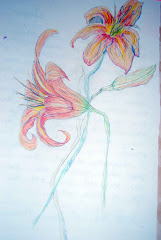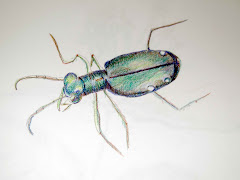





 On Sunday, Sue P. and Jackie D., along with her three lovely young granddaughters, headed over to Moreau Lake State Park for some snowshoeing, but when we got there, found the snow not right for snowshoeing, so we headed off toward the lake. It was my first time traversing this lake in its frozen state, and it was quite exciting. My perspective on the whole place, an area that I have visited often, changed enormously when standing in the middle of the lake!
On Sunday, Sue P. and Jackie D., along with her three lovely young granddaughters, headed over to Moreau Lake State Park for some snowshoeing, but when we got there, found the snow not right for snowshoeing, so we headed off toward the lake. It was my first time traversing this lake in its frozen state, and it was quite exciting. My perspective on the whole place, an area that I have visited often, changed enormously when standing in the middle of the lake!Because Jackie and Sue had both taken the tracking class with Vince Walsh last week, observing the different tracks in the snow was uppermost on both of their minds, and I got the benefit of some of what they had learned. It was so interesting to hear them talk about the size and depth of the print, the age of the track, and the distance between the prints, the gait of the animal, all as clues to the identity of the mystery animal. I’d obviously missed a lot by missing that class.
We all got pretty intrigued when we thought we were seeing some moose tracks. (This was not too far-fetched an idea, as a number of these animals had been spotted in the vicinity late fall.) We followed the tracks where they seemed to move back toward the bank, and up the slight incline, but this was conjecture, because the prints had been obliterated by lots of human prints near the shore. Then we started back-tracking, trying to find where they had started, which we weren’t able to do, seeing as the snow had blown over the prints, leaving tracks that stopped short, and an impression that this very heavy animal had sprouted wings and flown!
We left scratching our heads and wondering, but when Sue reached home, she did some research, and thought to compare horse hoof prints, and bingo! There was the mystery solved!
We did, however, see fox prints, and lots of evidence of beaver and muskrat activity. In fact, we saw a small downed willow, with tons of wood shavings on the snow, and when we inspected the trunk, where the severing from the main trunk had occurred, we saw big beautiful teeth marks. It was pretty amazing to think that this animal downed a tree with only his teeth for a tool!
When we left the lake and walked along in the woods, Jackie pointed out a witches’ broom to me. I had always seen these and wondered what they were. Upon doing some research, I found that they are a kind of gall, caused by rust fungi. Longan gall mites launch a parasitic attack on the plant cells, which causes abnormal growth within the tissues of the plant. This stimulates extra growth in the place of one shoot, and the mites then feed on this extra plant material. They are usually seen in birches (though can be found in pine, elm and other trees, as well) and they get their name from the many, small, shooting branches that originate from a common center, resembling a witches’ broom. It was once believed that these appendages appeared after a witch had flown over the tree.
But, at times, they take the shape of what looks like a bird’s nest, so sometimes, when we look up into bare, winter trees, and we think we are seeing old bird’s nests, what we are actually seeing are these galls. The good news is they don’t appear to harm the trees, and in fact, a mature birch can support up to a hundred of them without showing signs of stress. An interesting little side note is handmade broomsticks were traditionally made from birch twigs.
Another note of interest for me on the walk, were some fungi we found growing on a fallen tree, Sue told me one of them was a birch polypore. When I inquired further from her, she very kindly sent me a link about this fungus. I was amazed by the story that I read: it seems that in 1991, a 5,300 year-old Copper Age man was found frozen in the Alps. Upon doing an autopsy, they found that the man had suffered from parasitic whipworms, which would have caused stomach pain and diarrhea. On a leather thong, around his neck, the man carried several birch polypore mushrooms. These mushrooms, it seems, contain antibiotic oils which would have worked on microbacteria, such as he suffered from.
I am forever humbled by the power of nature, and the wisdom that seems, somehow, magically, or mystically, to be born where it is most needed. I feel that I am part of a generation that is beginning to discover, and appreciate the old wisdom, and to re-embrace it. And everyday that allows me to go out into the natural world, to discover all of these amazing sights and sounds, causes yet another wave of gratitude, in this very humble heart!





Thanks for the photos and story about our adventure last Sunday on Moreau Lake, as well as the info about birch polypore. Have you checked the Kawing Crow website for some upcoming events with Vince Walsh? He's very tuned in to nature wisdom and native ways. You'd love what he has to teach.
ReplyDeleteI love this blog and learned a lot. Very interesting about the frozen man and the mushrooms. Wouldn't you just love to be able to go for a hike and forage along the way and not take a sandwich or water along? That is forgotten knowledge I sure would love to have.
ReplyDelete